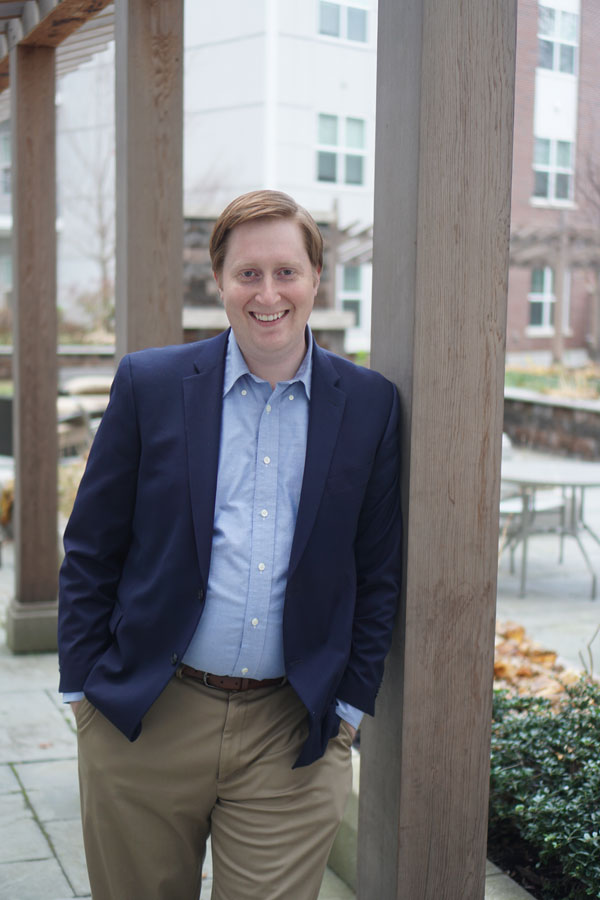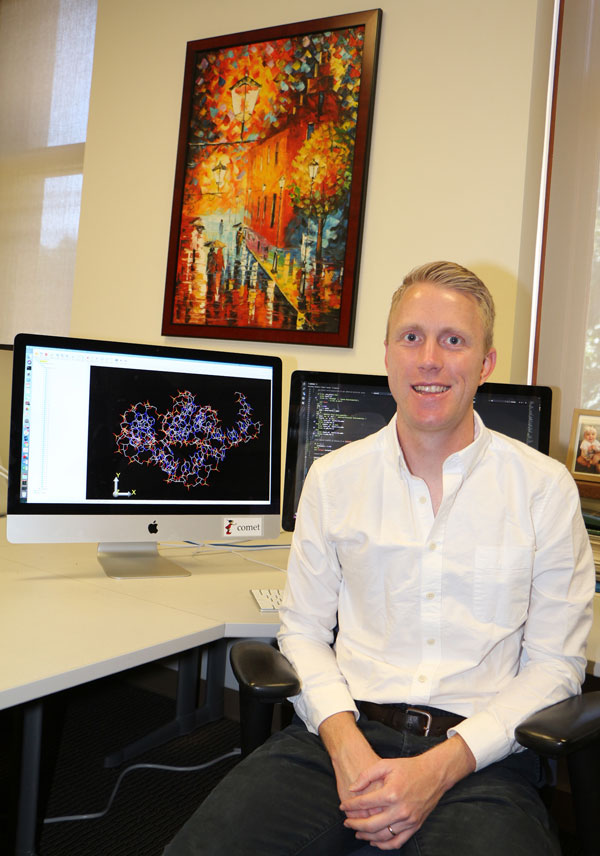Since 2004, Harry S. Truman Fellows in National Security Science and Engineering have come to Sandia each year to pursue high-risk, high-reward ideas that support the Labs’ national security mission.
This year, Sandia welcomes 2020 fellows Thomas Hardin and Josh Rackers, who began their three-year postdoctoral appointments this month.
“These two individuals stood out because we recognized a particular potential for them to make a positive impact on many mission areas,” said Grant Heffelfinger, director of advanced science and technology program management, who approved the selections. “I’d like to thank the Truman selection committee for the time and energy they put into evaluating an exceptional pool of candidates.”
Fellowships are extended to early-career researchers at the top of their respective fields. The selection committee, comprising senior scientists, evaluated each applicant.
The fellowship program also serves as an employment pipeline. Of 30 honorees, 18 joined the technical staff, and eight are still working at Sandia. Applications for fellowships starting next year will be accepted until Nov. 1, 2019.
Lab News spoke to the incoming fellows about their proposed research.
Thomas Hardin: Keeping it glassy

Thomas is a materials scientist with expertise in the molecular dynamics of glass. He comes to Sandia from the Massachusetts Institute of Technology, where, in the process of completing his thesis, he discovered how little is understood about the structure and properties of glassy materials on the nanoscale. His three-year assignment begins with an endeavor to fill in those gaps.
He joins mentor Mike Chandross and manager Veena Tikare. “I’m really looking forward to having Thomas be a part of our team,” Mike said. “I think that he’s going to make a lot of progress on this really difficult problem, and I can already see a number of other projects where his skills and knowledge will be extremely valuable.”
Also, Thomas speaks Finnish, to which we say: Emme ymmärrä sinua!
What’s one thing people might not know about glass?
When I talk about glass, I’m referring to an entire class of materials stretching from the glass in your phone screen to fiber optic cables, vitrified nuclear waste and metallic glass materials with exceptional strength-to-weight ratios. It’s so much bigger than window panes. And what all these materials have in common is their disordered atomic structure.
Why does their disordered structure matter?
In many metals and ceramics, the atoms are arranged in neat, orderly planes and rows. In glassy materials, however, the atoms are arranged in a disordered fashion. This disordered atomic structure can produce useful mechanical, optical and magnetic properties, among others, but also usually results in brittleness. Brittleness is one of the basic issues limiting the applications of glassy materials.
My proposed research is to systematically enumerate the fundamental structural building blocks of glassy materials. I want to look at small clusters of atoms in glass and figure out which atomic arrangements promote which properties. If we can figure out how to encourage formation of less-brittle configurations while retaining the useful properties that make glass attractive in the first place, that will be a huge win.
What impact do you hope to make through your research?
My work will enable rational design of new glassy materials with reduced brittleness and enhanced useful properties like optical transparency, corrosion resistance or strength. This will expand the envelope of engineering applications where glassy materials are viable. I’m also hoping that my work will underpin improved joining and additive manufacturing techniques for glassy materials.
Josh Rackers: Biologically inspired

Josh is a computational biophysicist. He credits his dad, an engineer, for getting him interested in science and for tricking him as a kid into thinking he could break the second law of thermodynamics. Now, Josh is designing new models for describing molecular dynamics in biological systems. Prior to joining Sandia, he earned a doctorate from Washington University in St. Louis.
“Josh will be a great colleague,” said Susan Rempe, one of his Sandia mentors. “He shares my interest in high fidelity theoretical predictions and curiosity about biophysical mechanisms. I can’t wait to work with him.” Josh will also be mentored by Steve Plimpton, Aidan Thompson and manager David Littlewood.
“Josh has insights into how to model important classes of soft materials at the atomic scale with high accuracy,” Steve said. “We think his ideas will complement and extend the methods Sandia uses for modeling other kinds of materials.”
What’s one thing you hope to accomplish as a Truman fellow?
The first thing I want to do is use computer simulations to understand how ion channels work. Ion channels are these molecules that sit in cell membranes, and they are ultra-important because they regulate how ions come in and out of cells. And by selecting which ions pass through, they’re able to make sure that our heart beats and that neural signals are sent. It’s also potentially important to things like water filtration and other industrial uses.
How do ion channels fit into your long-term goals?
As a general matter, the big goal is to be able to take any molecule you’re interested in, plug it into a computer and ask, “How does it move? How does it interact with something else?” And related to that, I’d like to develop tools that allow that to be done by anyone.
And then I guess the big, meta goal is to advance this perspective — even outside of science — that the behavior of our world, or at least the molecular world, can be completely understood from understanding how atoms bounce off each other — that everything comes from those atomic-level interactions.
What are you looking forward to about Sandia?
There seems to be a real openness to trying research that is not guaranteed to work, but a good idea. And that’s kind of a fun place to be. I’m really also looking forward to pushing the biomolecular research frontier at Sandia. Right now, it’s a relatively small chunk of what Sandia does, and I’m looking forward to seeing if that can grow over time.